This post may contain affiliate links. Please read our disclosure policy.
THIS IS IT GUYS! The vegan cheese you have been looking for. Sharp, and creamy with a white and flowery rind, this vegan camembert is simply mind blowing! Made using traditional cheese-making techniques and just 5 ingredients!
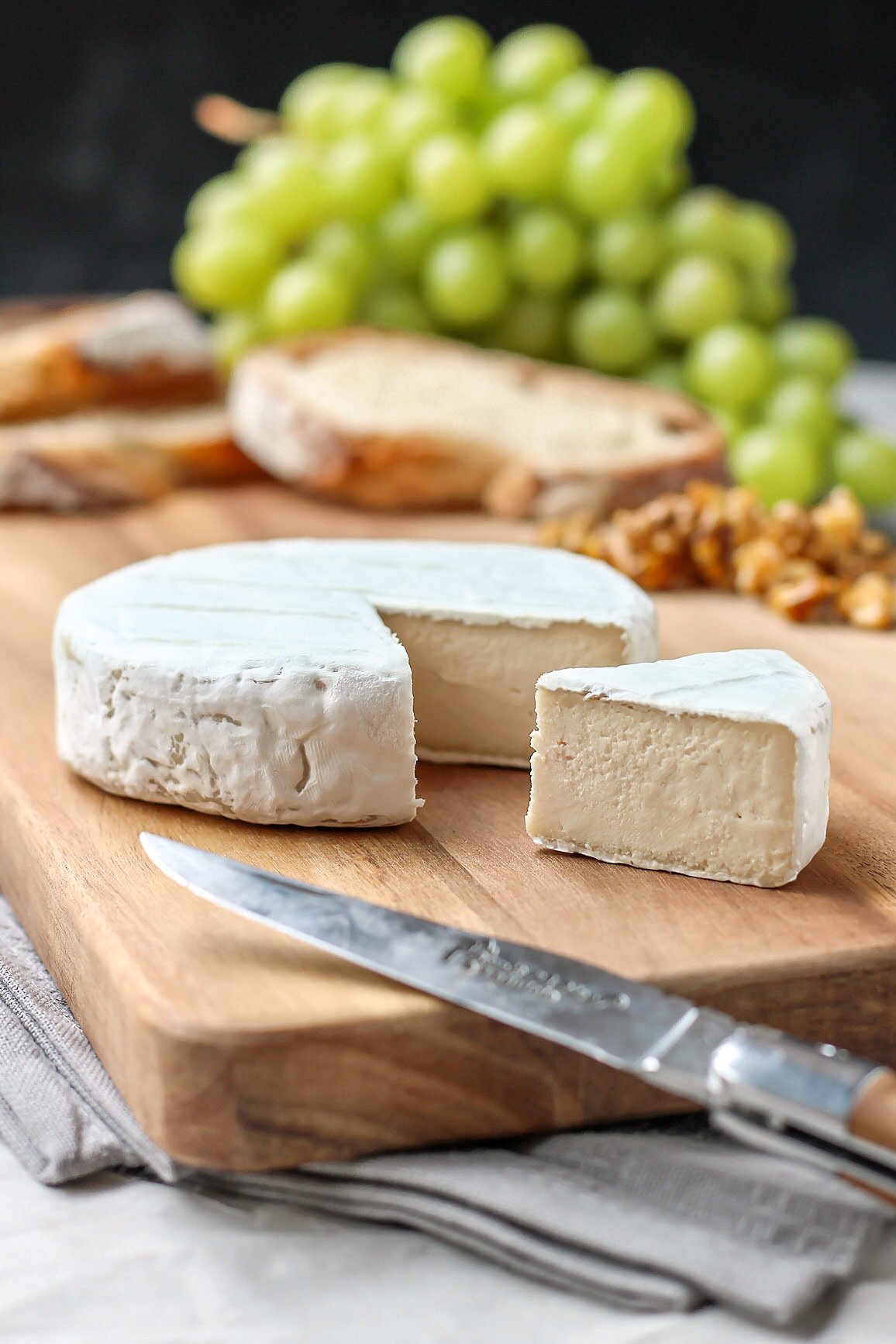
After months of research and testing, I finally found how to make a nut cheese with the taste and texture of a real camembert. Living in France, I ate quite a lot of artisanal cheese before going vegan, and I can tell you this one seriously taste like a real one.
⭐️ Why You Should Try This Recipe
- The flavor and texture are incredible. Creamy on the inside, slightly chewy on the outside, and perfectly tangy, I can confidently say this vegan camembert tastes SO much better than most other vegan cheese recipes.
- Made using traditional techniques. While cashew cream replaces dairy milk here, we are using traditional cheese-making methods to age this cheese, giving it a true cheese aroma. There is no nutritional yeast or flavorings used here. It all comes from the cultures and the aging process.
- The reviews speak for themselves. With over 250 ★★★★★ ratings, it’s no question readers love this camembert!
- It’s healthy. This vegan camembert is packed with healthy fats and probiotics that can help improve gut health.
📘 What is Camembert
Camembert is a soft and creamy cheese that first appeared in Normandy, France, around 1554. It is inoculated with a mold called “Penicillium Candidum”, responsible for producing a bloomy rind, and is usually aged for 2-3 weeks.
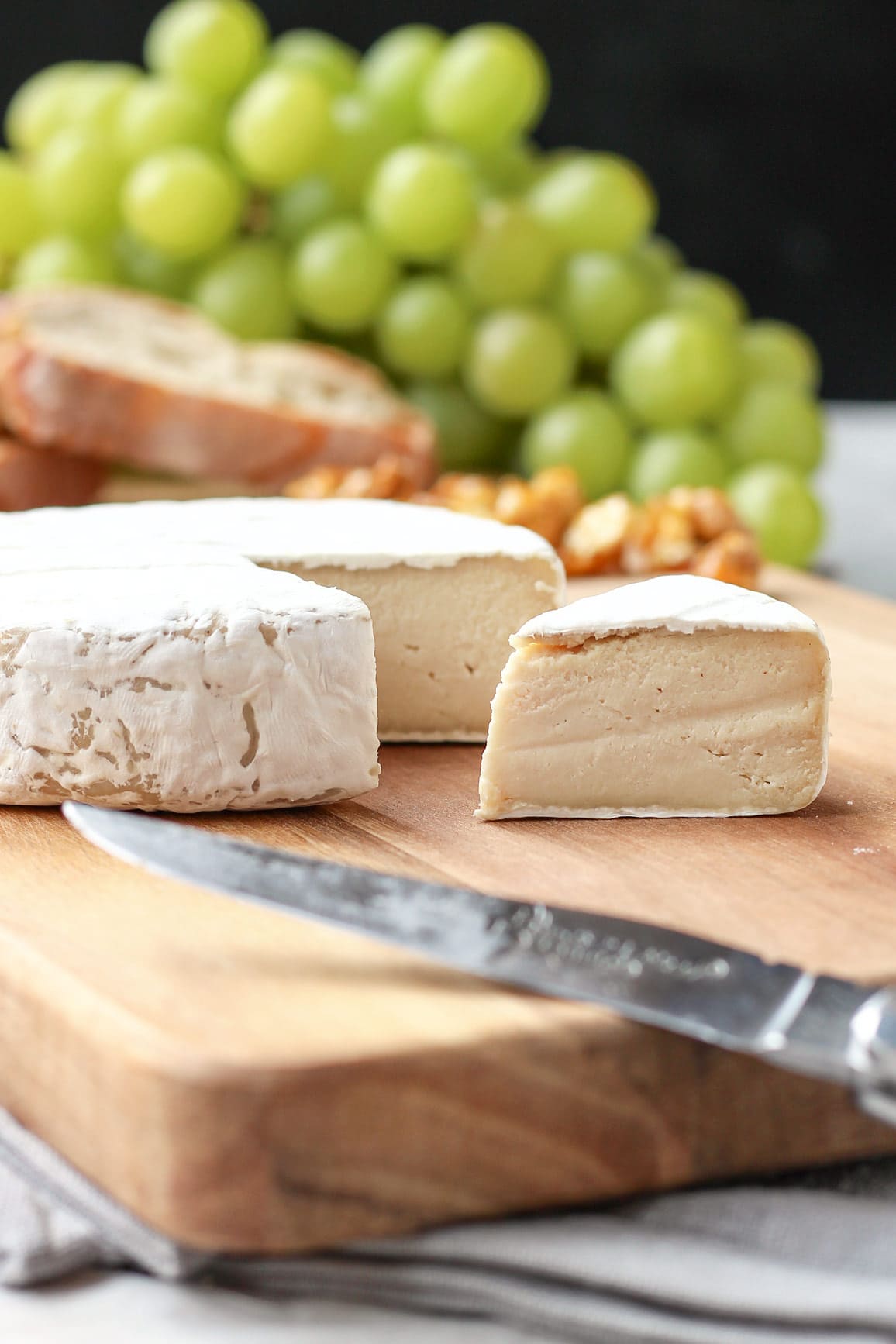
🥛 Ingredient Notes
This cheese contains only FIVE ingredients: raw cashews, cultures, water, salt, and the secret ingredient for the rind: Penicillium Candidum. Here are some notes about each ingredient:
- Cashews – Cashews make the base of this cheese. You want to use raw cashews, not roasted ones.
- Probiotics – These will give the cheese its tanginess. You can use acidophilus or mesophilic culture. Check out the Tips to read more about it.
- Penicillium Candidum – Penicillium Candidum is a mold that grows on camembert/brie and gives it a white and soft rind. It also adds a lot to the taste by giving a mushroomy flavor. It’s an essential ingredient to this recipe and cannot be omitted or substituted.
- Water – To blend the cashews and turn them into a cream. I recommend using filtered water or water that has been boiled and cooled down.
- Salt – For flavor and to prevent bad bacteria from growing.
🥣 How To Make Vegan Camembert
Before starting: Be aware this is not a quick recipe, don’t expect to have vegan camembert ready tonight. The whole process will take you about three weeks. BUT: It is totally worth it!
1. Prepare the cashew cream
- Drain the soaked cashew and transfer them to a high-speed blender. You can use a food processor, but you won’t get the same silky smooth texture.
- Add the water and blend on high speed for 1-2 minutes or until it forms a thick and smooth cream.
- Sprinkle the acidophilus probiotic and the Penicillium Candidum and blend for another 5-10 seconds.
Note: There are two methods to innoculate the Penicillium Candidum. The first one consists of mixing it into the ingredients directly. The second one consists of spraying it on the outside of the cheeses after they have been shaped. I used the first method here, which gives the best result, in my opinion.
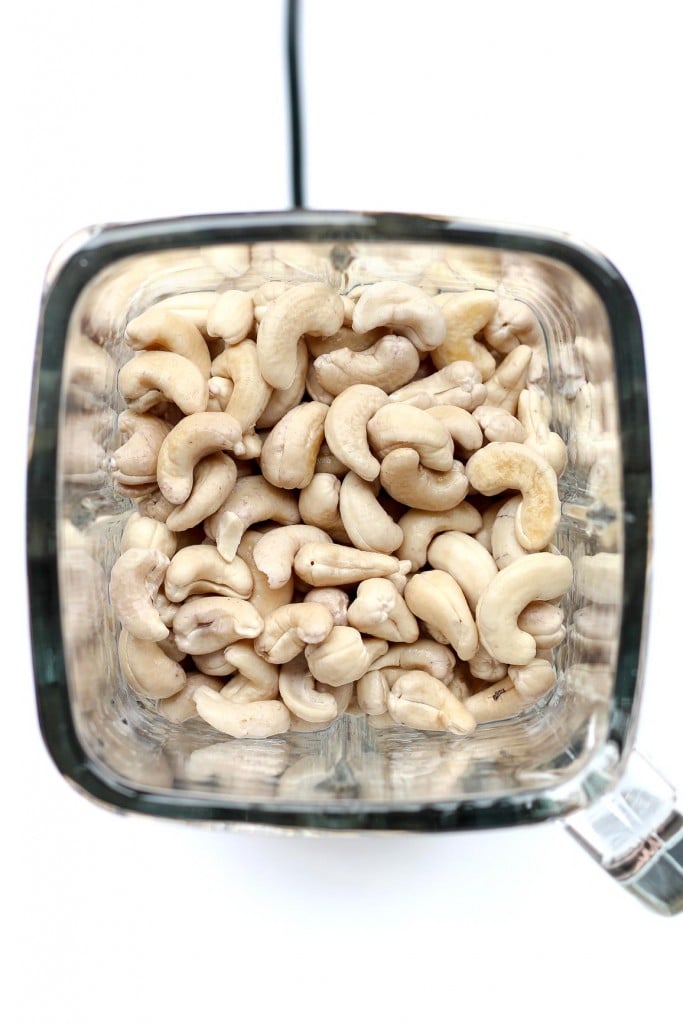
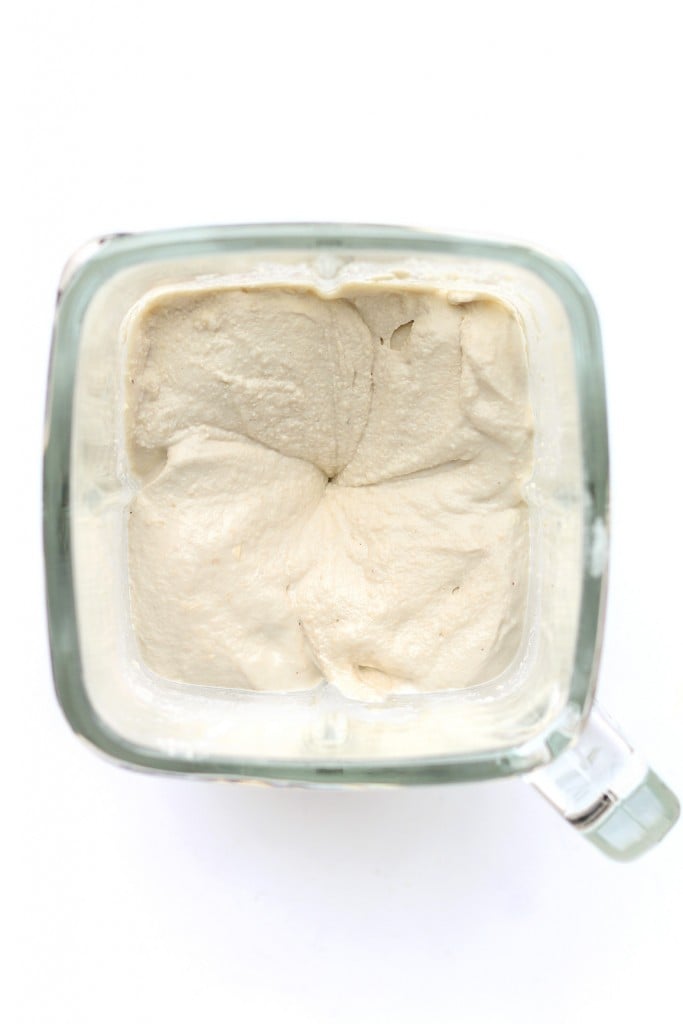
2. Let the cashew cream ferment
Once you have a very smooth and thick cashew cream:
- Transfer it to a clean bowl and cover it with plastic film to touch.
- At this point, let the cashew cream ferment at room temperature in a dark place for 24-48 hours.
- After that, the cashew cream should have small bubbles and a fluffy texture. This means the fermentation process worked. You can taste it. It should have a subtle tanginess.
- Transfer the fermented cashew cream to the refrigerator and chill for at least 4 hours or overnight. This step will allow it to firm up a little bit.
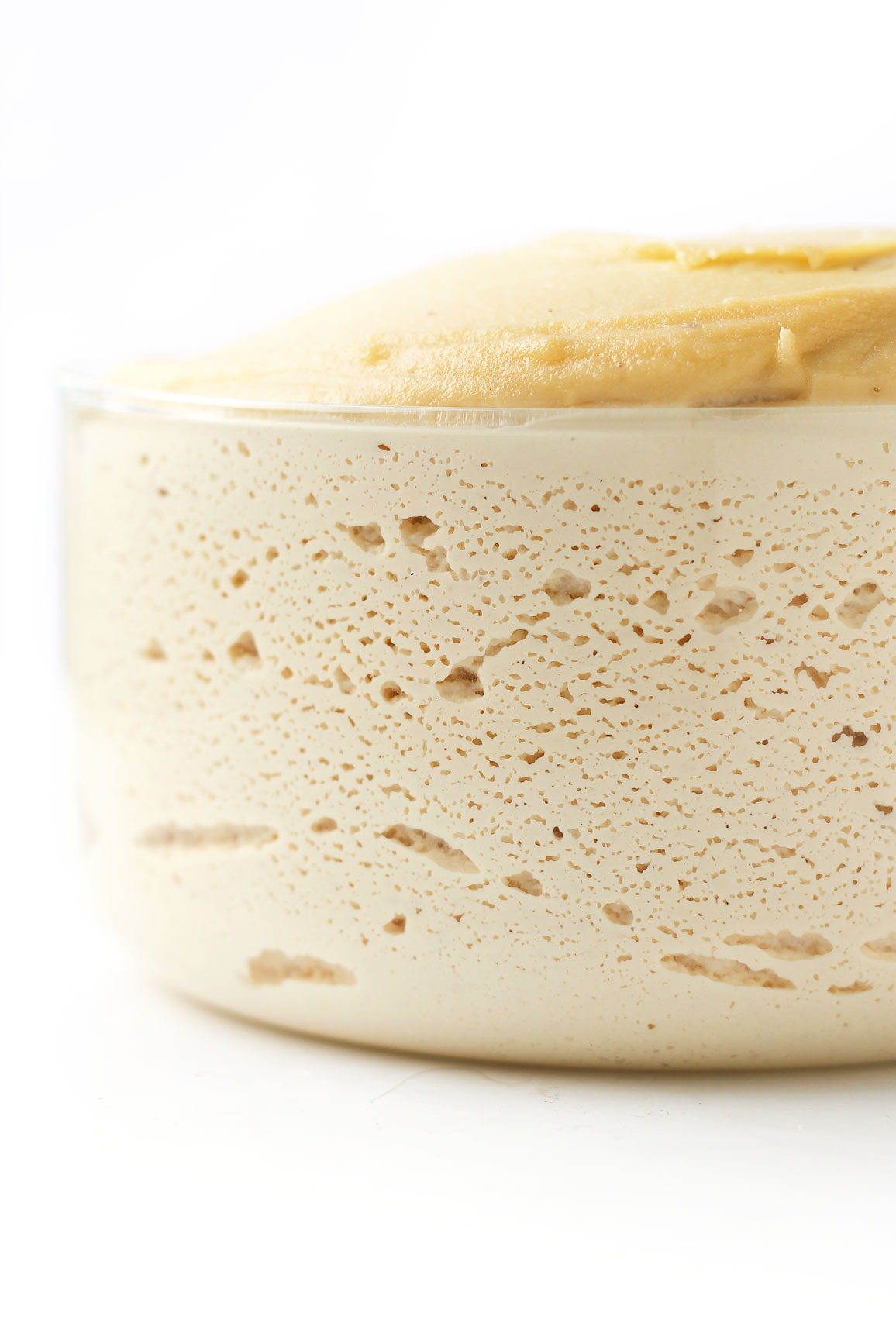
3. Shape and salt the cheeses
- Line 3 springform pans (I used these Wilton 4-inch springform pans) with parchment paper or plastic wrap, covering the bottom and sides. The goal is to prevent the cheese from touching and sticking to the metal.
- Fill each pan with the cashew cream mixture and press it down using plastic film, so it doesn’t stick to your hands. Cover with plastic film to touch.
- Refrigerate overnight.
- The next day, carefully remove the cheeses from the springform pans and place them in a container lined with parchment paper. Be careful, the cheeses will be very soft (like a thick cream).
- Sprinkle about 1/4 tsp of salt over the top of each cheese, and rub with your finger to evenly distribute the salt. Carefully flip the cheeses and sprinkle the bottoms and sides with more salt.
- Close the container and place it in your refrigerator (in the warmest area) or a room at a temperature of 52-56°F (11-13°C).
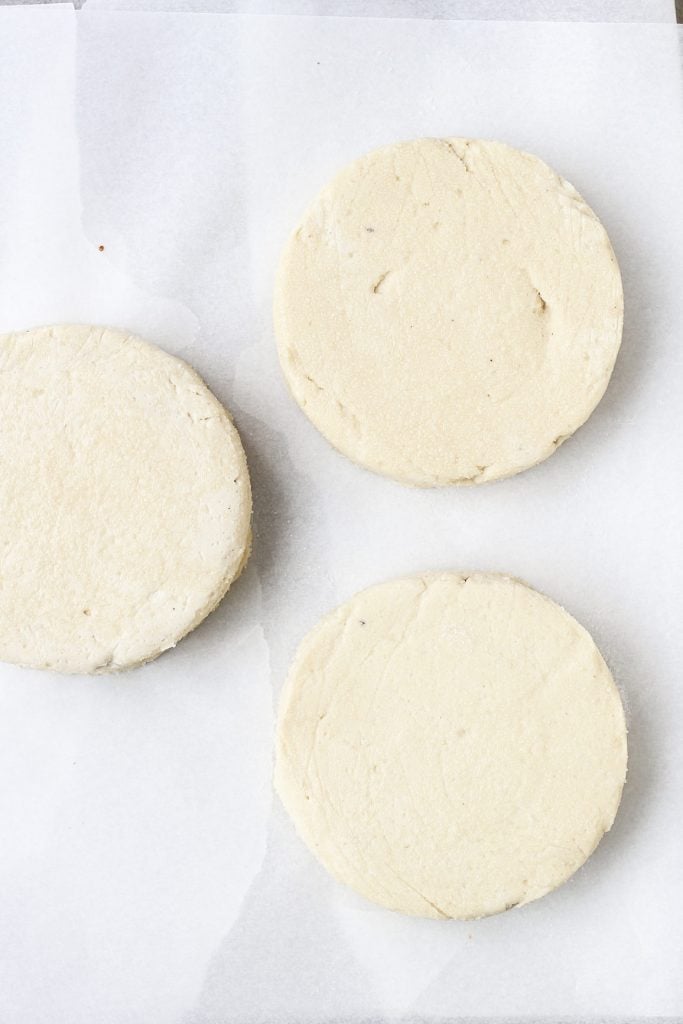
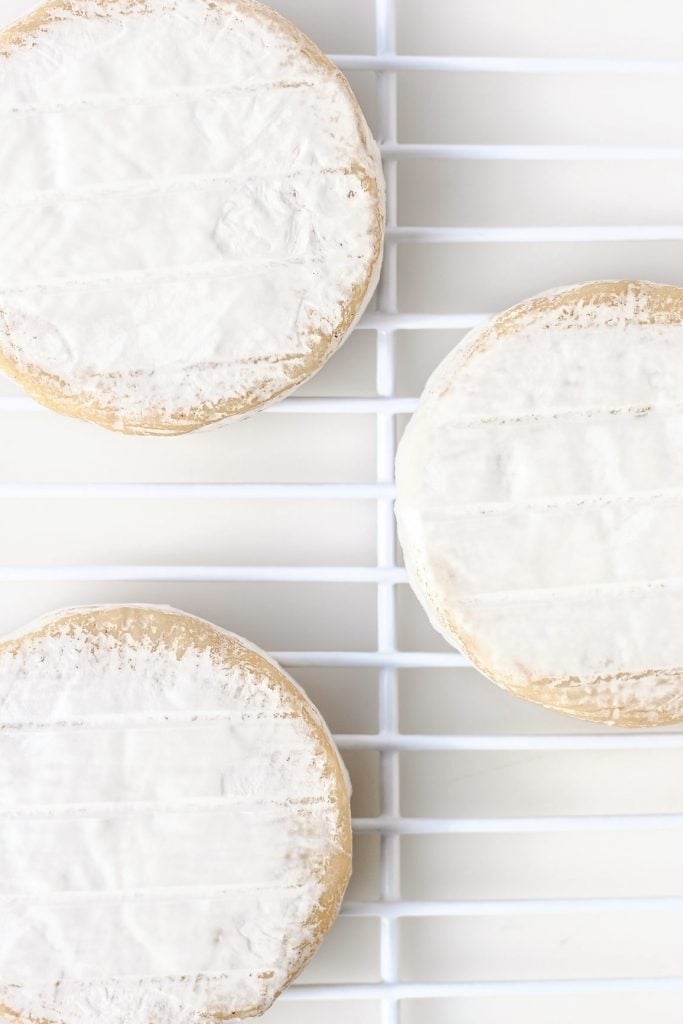
4. Age the cheeses
Finally, the most exciting step!
- Every day, carefully flip the cheeses. The cheeses will be very soft at the beginning, like cream cheese. Don’t worry; they will firm up after a few days. If you see water or condensation in the container, remove it using a kitchen paper towel.
- After 7-10 days, the cheeses should be slightly firmer. At this point, you can place them on a clean grid (that fits in your container). If you don’t have a grid, place the cheeses on chopsticks. This will allow airflow, and the mold will grow more uniformly.
- Continue flipping the cheeses every day for the next 7 days. The mold will start to appear in the following days if it hasn’t appeared already.
- After a total of 2 weeks, the cheeses should be fully covered with a white and fluffy rind. You are almost done!
- Wrap the cheeses in parchment or cheese paper and place them in the refrigerator for at least 2 days. The longer you let them age, the sharper they will become.
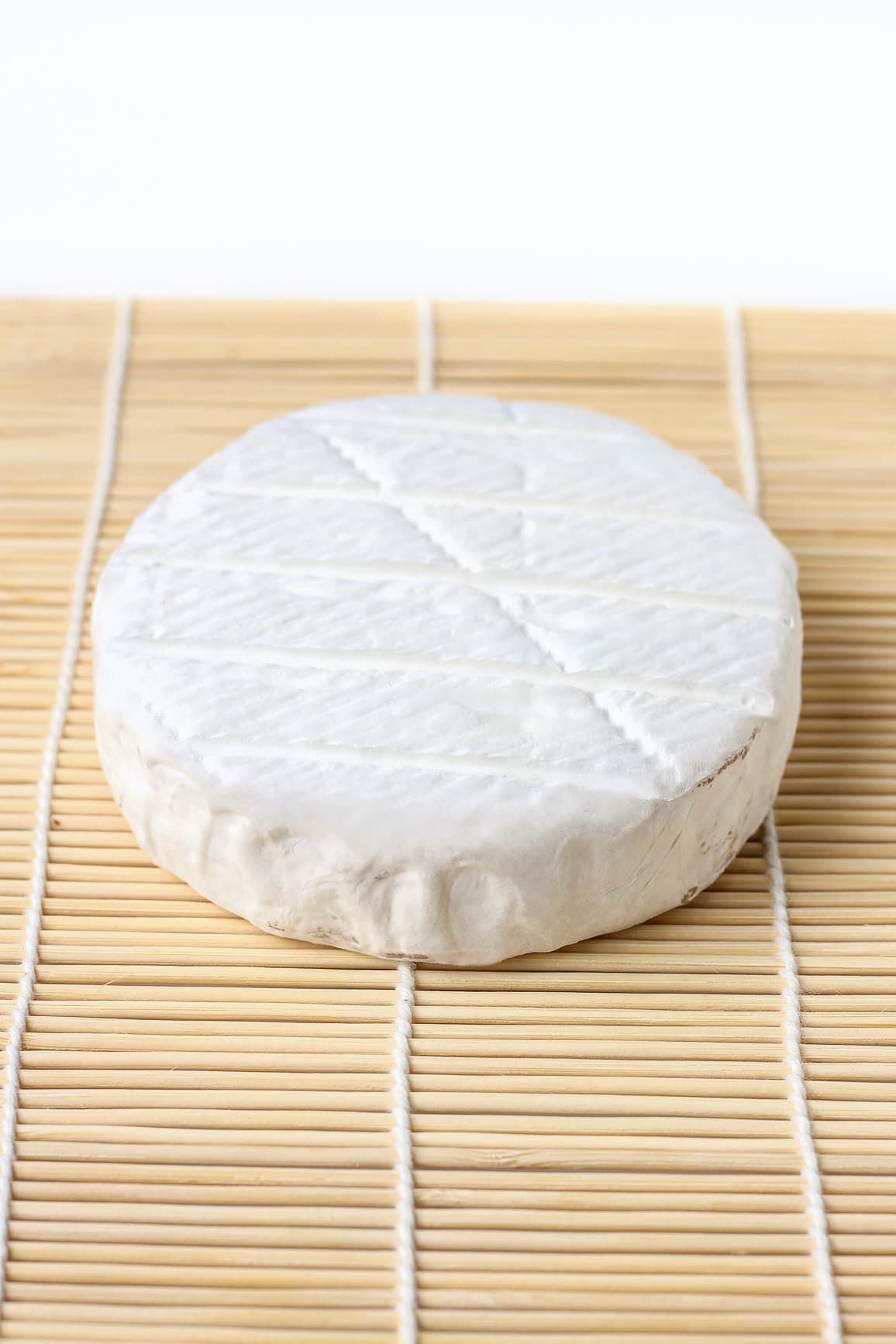
🥖 How To Serve It
Enjoy with french bread, Vietnamese baguette, fig chutney, caramelized walnuts, or even a drizzle of pure maple syrup if you like the combination of sweet and salty.
Regarding beverages, this camembert pairs well with cider, Champagne, Cabernet Sauvignon, apple liquor, beer, or a good apple juice if you don’t drink alcohol. The apple undertones of cider or apple juice contrast very well with the slight bitterness of the camembert!
❄️ Freezing
After aging the cheeses, wrap them in cheese paper or plastic film. You can keep them in the freezer for up to 3 months. Thaw overnight in the refrigerator.
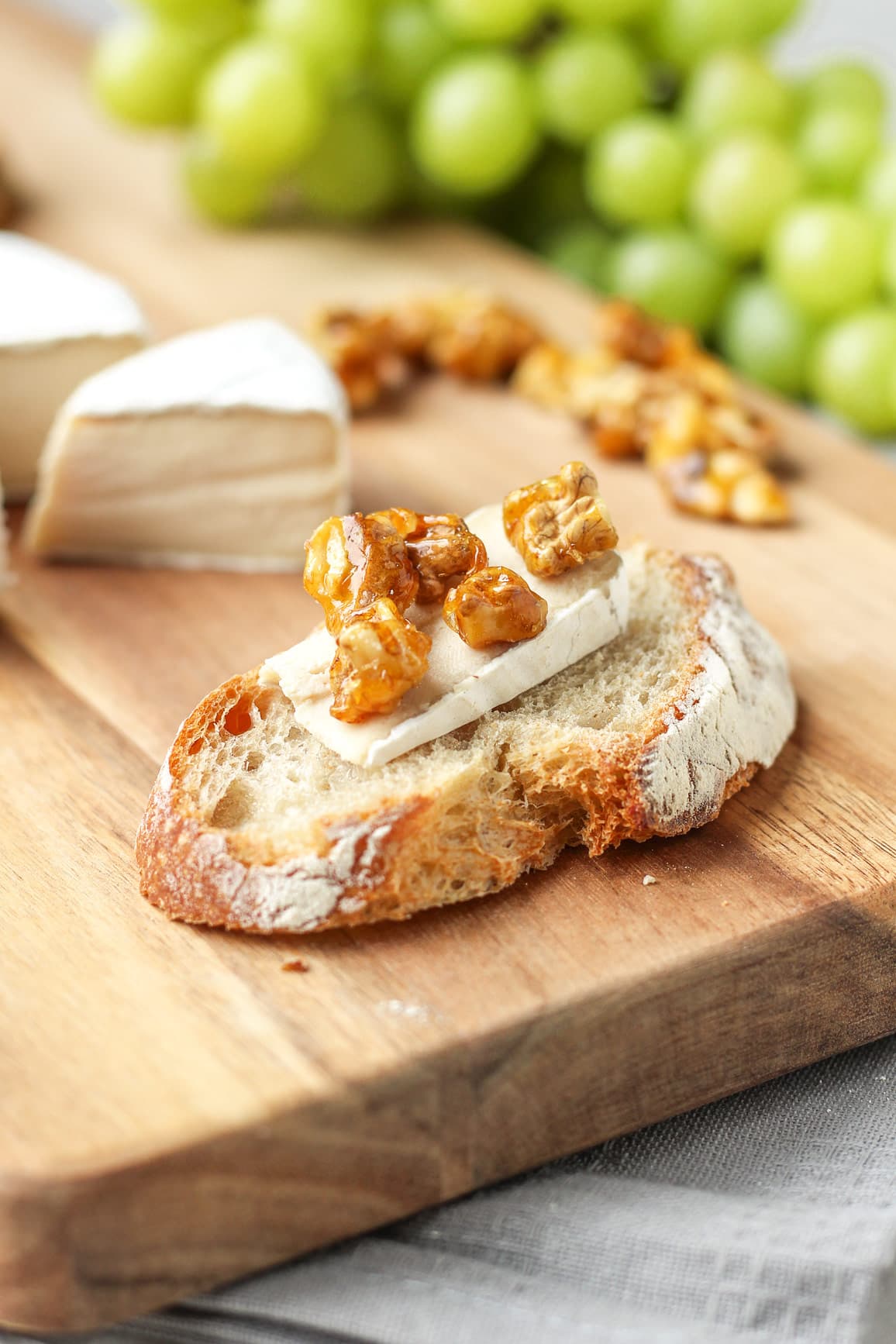
📔 Tips
- Do not omit or substitute any ingredient. This recipe is not versatile. If you want to succeed with it, do not change the ingredients or method.
- Use gloves. While not mandatory, I recommend using gloves while handling the cheeses. It will prevent bad bacteria from contaminating your cheeses.
- Regarding the Penicillium Candidum: The links provided here for Penicillium Candidum may not redirect to a fully vegan product. If you want to find a 100% vegan one, you will have to do your own research (it’s available in many cheese-making shops). Be aware that non-vegan ones are grown on lactose, meaning it contains *traces* of lactose. Considering the amount used, you could still consider your cheese 99,99% vegan. It’s up to you to choose which one fits your beliefs best.
- Regarding the Acidophilus: In this recipe, I used the Advanced Acidophilus Plus from Solgar, which contains 500M microorganisms per capsule. You can use a different brand, but you may have to use less if it contains more microorganisms. Alternatively, you can replace the acidophilus with 1/16 teaspoon of mesophilic, which is a culture made specifically for cheese making. It will yield a slightly less tangy and more buttery flavor.
- Depending on the temperature in your fridge/aging room, the mold might take more or less time to develop. The colder the temperature, the longer it will take to develop.
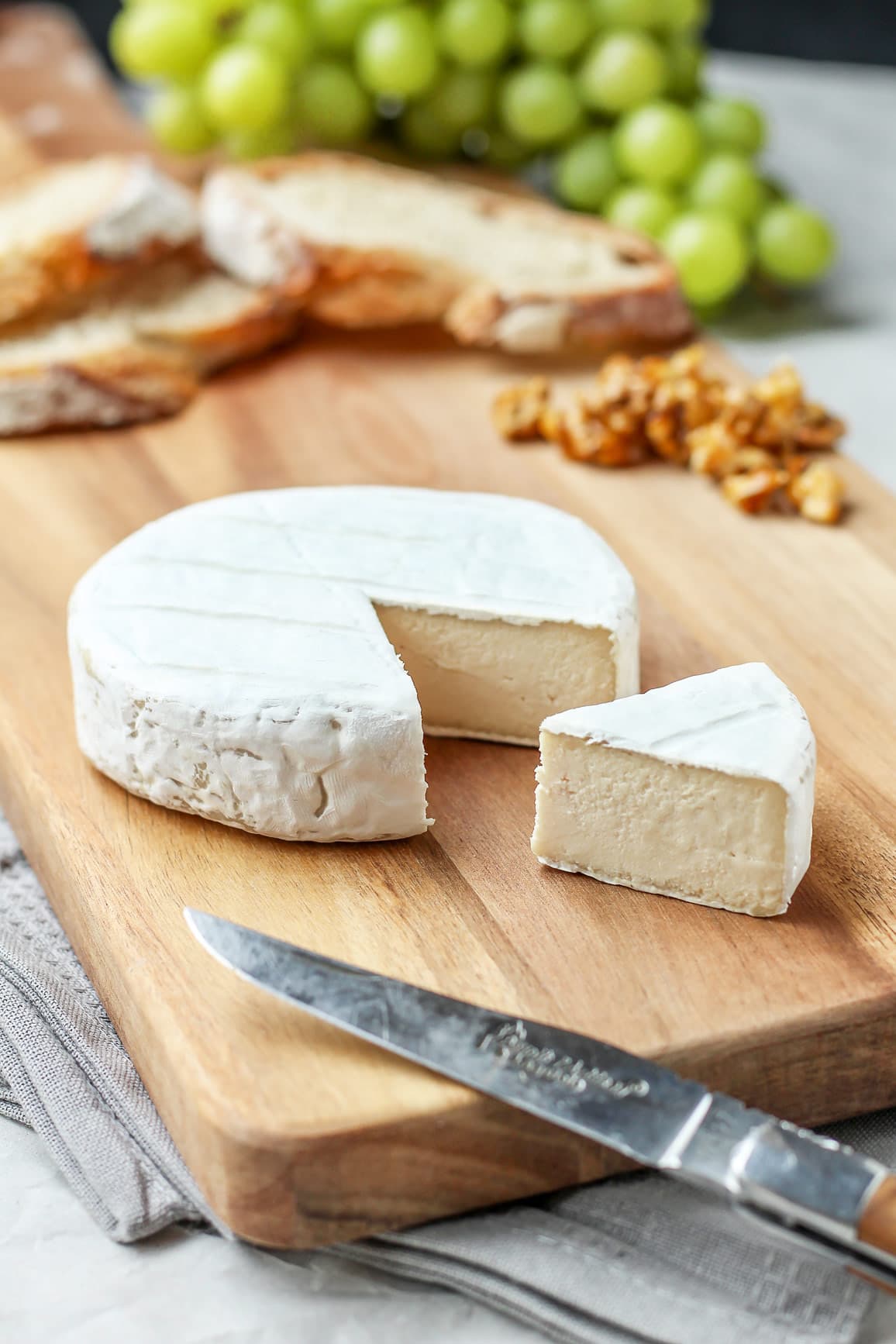
💬 FAQ
Yes! It is totally safe to eat the rind. That’s actually where most of the flavor lies!
Vegan camembert has a nice tanginess and earthiness with notes of mushrooms and butter.
You can find it online on cheese-making websites or ask your local cheese maker to sell you some.
While some readers had success using a mix of different nuts, I haven’t personally tried it yet. I recommend sticking to cashews for a creamy consistency.
No, Penicillium Candidum is essential to this recipe. It’s responsible for the flavor and texture.
After the aging process, vegan camembert will keep for up to one month in the refrigerator, wrapped in cheese paper. Once cut, it will keep for about 1 week.
No, this vegan camembert doesn’t melt but will soften when heated.
Both kinds of cheese originate from different areas of France. One comes from Normandy, while the other comes from “Île-de-France.” The other difference is that Brie is often larger than the camembert, weighing around 100 pounds instead of 9 ounces for the camembert. If you want, you can shape this vegan cheese into a large wheel instead of 3 small ones to make vegan brie!
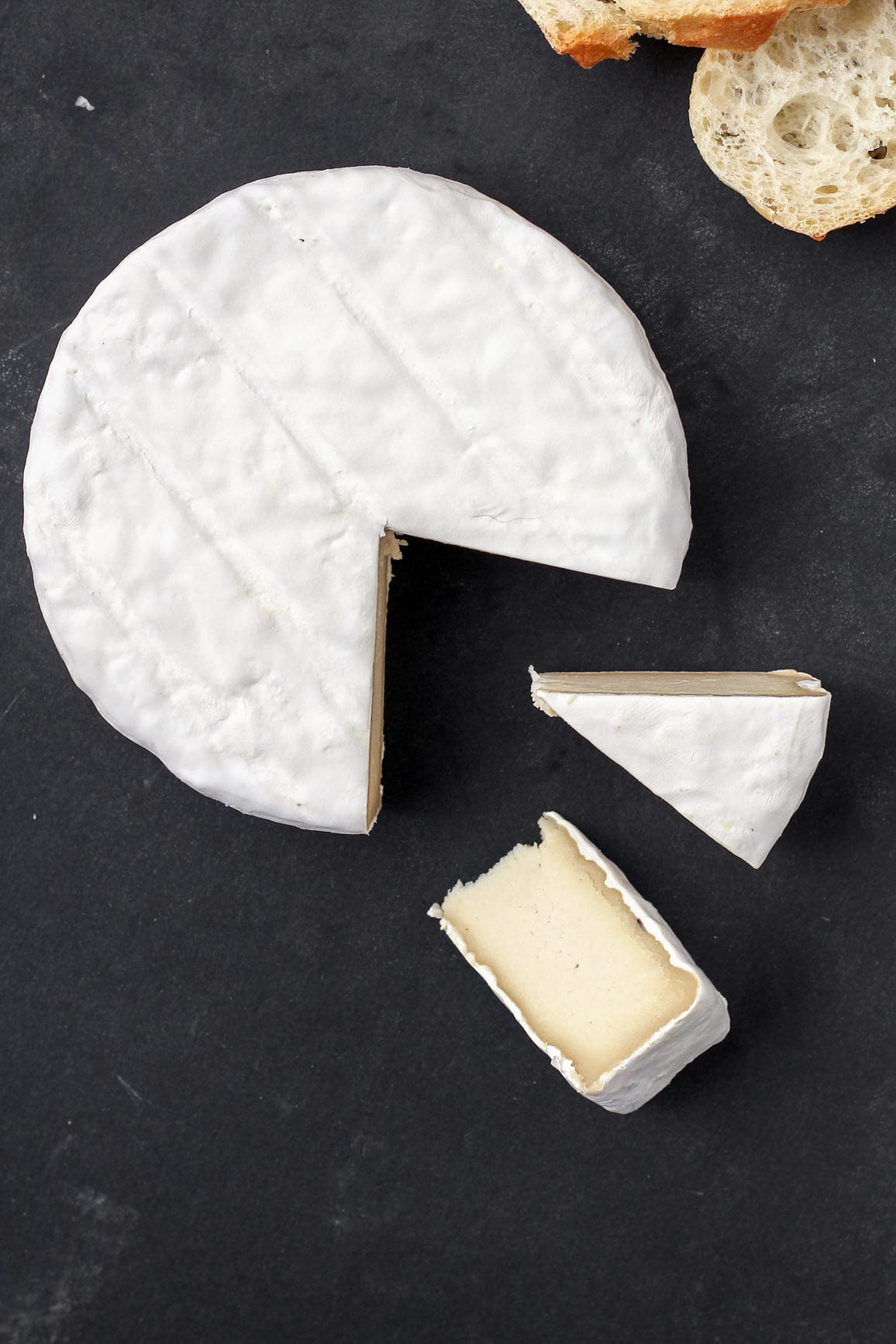
This vegan camembert will surely impress any cheese lover and even your non-vegan friends! It’s creamy, rich, and just delicious!
Disclaimer: Many people have been making this cheese without giving any credit and labeling it their own. I worked really hard to create this recipe and had to do a ton of experiments before releasing it. Please give credit by citing Full of Plants and linking to this website.
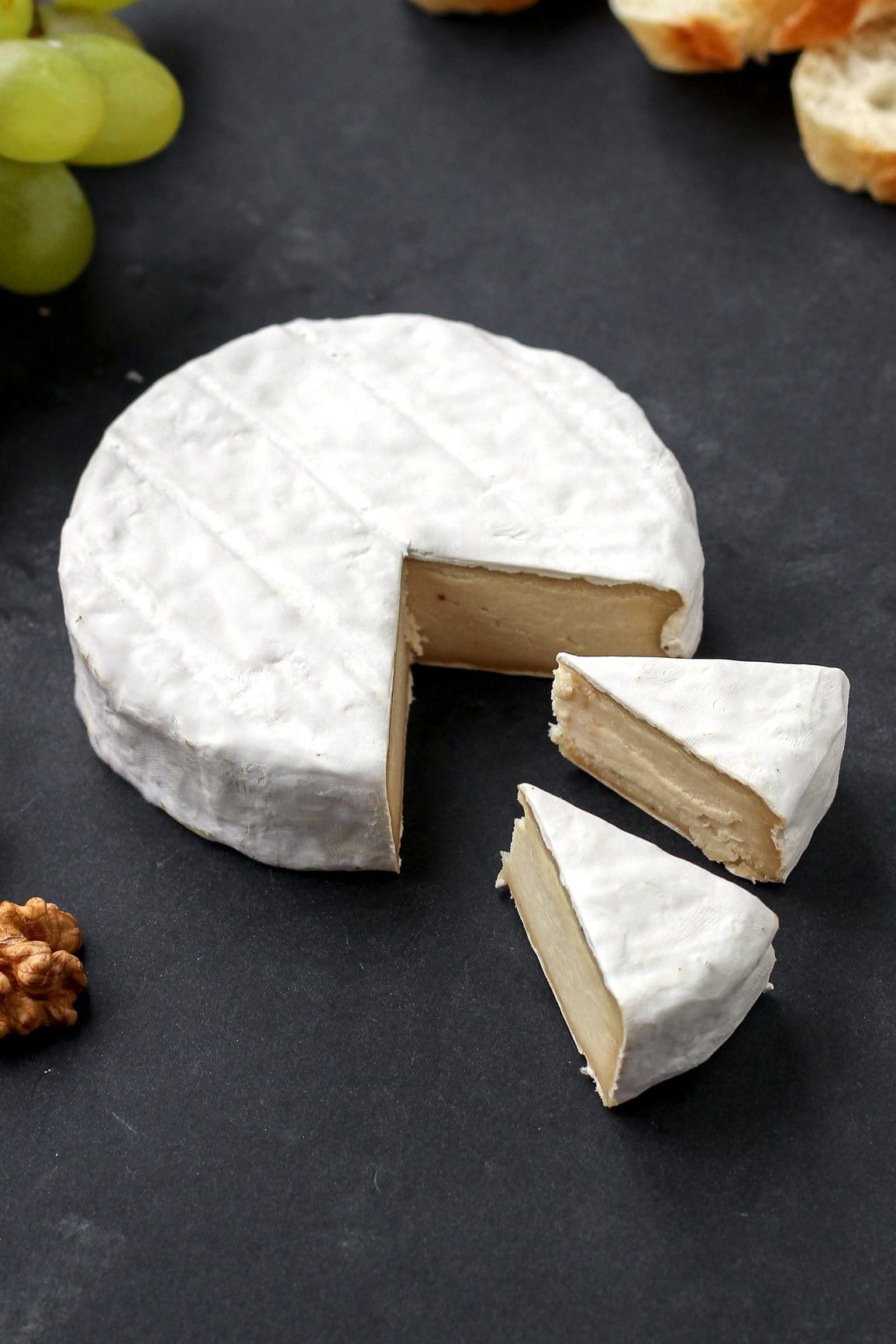
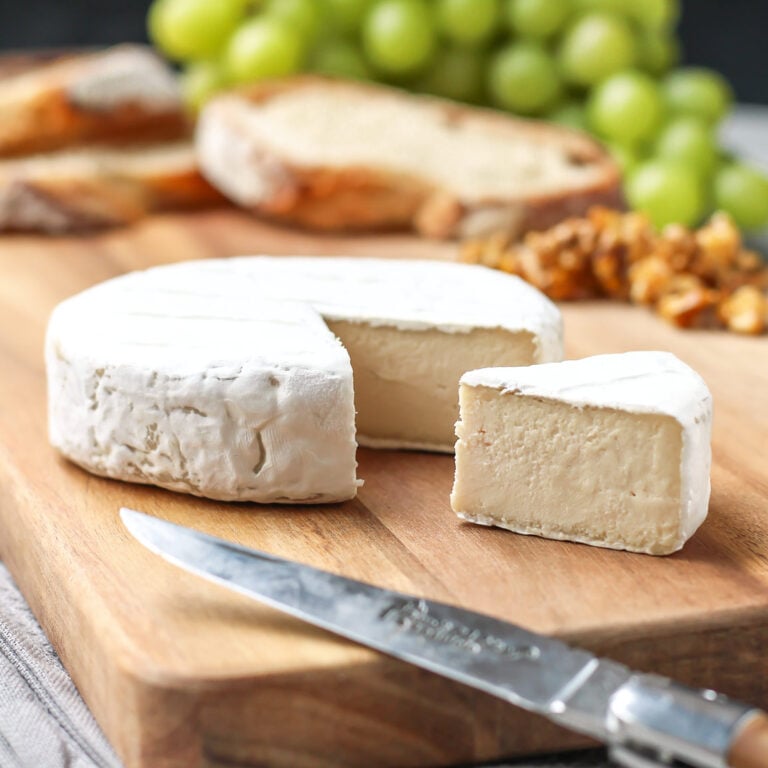
Vegan Aged Camembert Cheese
Ingredients
- 4 cups raw cashews soaked overnight
- 8-10 tbsp filtered water (or boiled water cooled down)
- 8 capsules Acidophilus probiotic or 1/8 tsp mesophilic
- 1/8 tsp Penicillium Candidum powder or liquid
- 2 tsp sea salt
Instructions
Prepare the cashew cream
- Drain the cashews and place them in a large glass bowl. Bring a large pot of water to a boil. Once boiling, pour the water directly onto the cashews. Let sit 1-2 minutes, and drain the cashews again. This step will help kill possible bacteria.
- Place the cashews in the bowl of a blender or food processor. Add 8 tablespoons of filtered water. Blend on high speed, scraping down the sides from time to time, until you get a very smooth cream. This step might take about 10 minutes, depending on your blender.
- Open the probiotic capsules and add the powder to the blender. Add the Penicillium Candidum, and blend on high speed for another 10-15 seconds.
- The cashew cream should be smooth but quite thick. If needed, add 1 tablespoon of water at a time until smooth. Do not add too much water or your mixture will be too liquid.
- Let it ferment: Transfer the cashew cream to a clean glass bowl, cover it with plastic film to touch, and let it sit at room temperature for 24-48 hours in a dark place. This step is important to let the cheese ferment and get a tangy flavor. Note: The cashew cream should have small bubbles and a fluffy texture. This means the fermentation process worked.
- Transfer the cashew cream to the refrigerator and chill for at least 4 hours (or overnight). The cashew cream will firm up a bit and become easier to work with.
Shape the cheeses
- Line 3 4-inch springform pans with parchment paper. You want to cover the bottom and sides. Alternatively, you can also use plastic film if you prefer. The goal is to prevent the cheese from touching the metal. Fill each pan with the cashew cream and press it down using plastic film, so it doesn't stick to your hands. Refrigerate overnight.
- The next day, carefully remove the cheeses from their springform pans and place them in a container lined with parchment paper.
- Sprinkle about 1/4 tsp of salt over the top of the cheeses. Next, using a plate lined with parchment paper, very carefully flip the cheeses. Sprinkle the tops and sides with more salt. The cheeses will still be very soft, like cream cheese. Don't worry, they will be easier to work with after 3-4 days, as salt will remove some moisture.
Aging
- Close the container and place it in your refrigerator (in the warmest area) or a room at a temperature of 52-56°F (11-13°C). Important note: You will age the cheeses at this temperature for the next two weeks. Do not store them at a temperature higher than 56°F (13°C). Also, the cheeses must stay in the closed container during the whole process, it will prevent them from drying.
- Every day, carefully flip the cheeses. Always use clean hands or work with gloves (or plastic film) to make sure you are not touching the cheeses. If you see water or condensation in the container, remove it using a kitchen paper towel.
- After 7 days, the cheeses will be a little bit firmer, and you should be able to place them on a plastic grid or chopsticks (that fits inside your container). This will allow airflow, and the mold will grow more uniformly.
- Continue flipping the cheeses every day for the next 7 days. The mold will start to appear in the following days, if it hasn't appeared already.
- After a total of 2 weeks, the cheeses should be completely covered with a white and fluffy mold. At this point, wrap the cheeses in parchment or cheese paper and place them in the refrigerator for at least 2 days. The longer you let them age in the refrigerator, the sharper they will become.
- Enjoy this vegan camembert with french bread, fresh figs, and/or nuts!
- Vegan camembert will keep for up to 1 month in the refrigerator.
Video
Notes
- Do not omit or substitute any ingredient. This recipe is not versatile. If you want to succeed with it, do not change the ingredients or method.
- Use gloves. While not mandatory, I recommend using gloves while handling the cheeses. It will prevent bad bacteria from contaminating your cheeses.
- Regarding the Penicillium Candidum: The links provided here for Penicillium Candidum may not redirect to a fully vegan product. If you want to find a 100% vegan one, you will have to do your own research (it’s available in many cheese-making shops). Be aware that non-vegan ones are grown on lactose, meaning it contains *traces* of lactose. Considering the amount used, you could still consider your cheese 99,99% vegan. It’s up to you to choose which one fits your beliefs best.
- Penicillium Candidum can be found in powdered and liquid forms. Both work the same. I usually use 1/8 tsp when in liquid or 1/16 tsp when in powder. If you do not own a 1/8 tsp, simply measure the powder using a fork or knife tip.
- Regarding the Acidophilus: In this recipe, I used the Advanced Acidophilus Plus from Solgar, which contains 500M microorganisms per capsule. You can use a different brand, but you may have to use less if it contains more microorganisms. Alternatively, you can replace the acidophilus with 1/16 teaspoon of mesophilic, which is a culture made specifically for cheese making. It will yield a slightly less tangy and more buttery flavor.
- Depending on the temperature in your fridge/aging room, the mold might take more or less time to develop. The colder the temperature, the longer it will take to develop.
Nutrition

About the Author
Thomas Pagot is the founder, photographer, and recipe developer behind Full of Plants. He created the blog in 2016 as a personal cookbook for vegan recipes. Through years of recipe development, Thomas has successfully grown Full of Plants into a trusted resource for plant-based recipes.
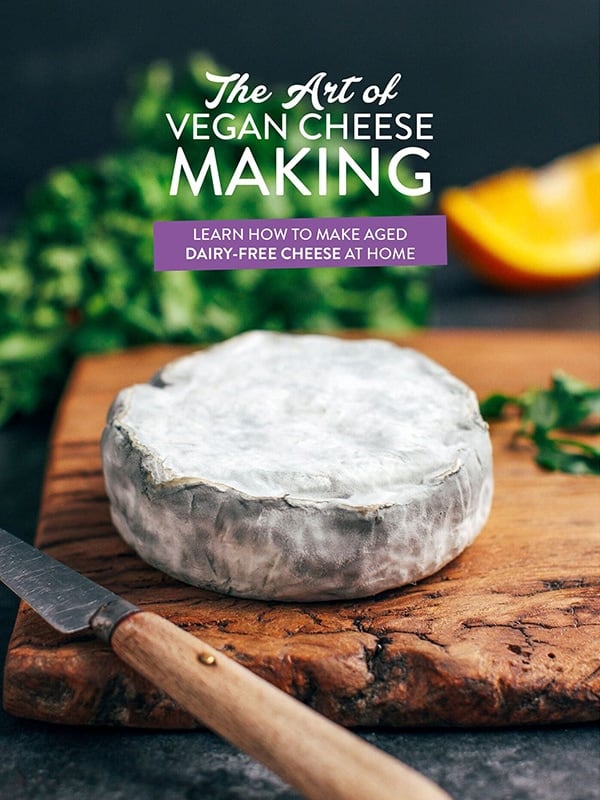
🧀 25 Mind-Blowing Vegan Cheese Recipes!
Sign up for the Full of Plants newsletter and you’ll get new recipes delivered by email weekly, PLUS your FREE 100-page printable eBook!
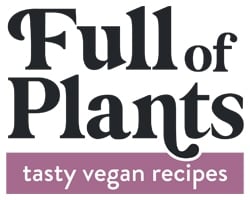
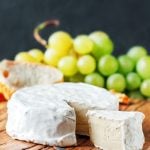
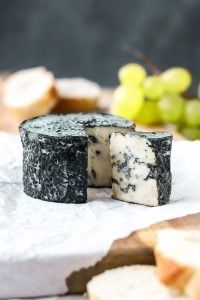
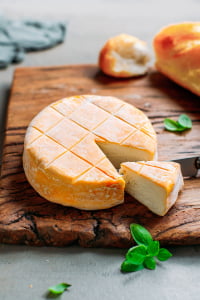
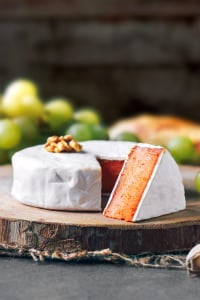
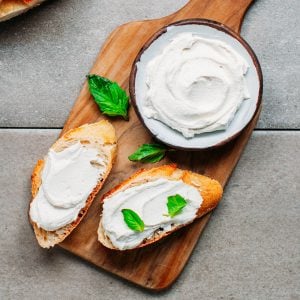
This is unbelievable! Thanks for sharing. I can’t wait to try it out. I was always a sucker for those rinded cheeses. Btw, your photos are stunning too.
Thanks Shannon!
Let me know how it turns out!
Hi, Thomas. It’s been a week since I salted the cheese, and there’s little sign of the rind growing. Shall I re-salt the cheese? Thank you x
I would not recommend to re-salt the cheese, or they will be too salty in the end. Are you aging the cheeses in your refrigerator? It usually takes more time when aging in a refrigerator.
If I understand correctly, the 2 tsp salt called for in the recipe is supposed to be used to salt the outside of all 3 cheeses, right? This is my first time making something like this and I wanted to be sure that I salt the cheeses appropriately. Thanks for your help with all of my questions!
You are correct, the salt is just to salt the exterior. 2 teaspoons is an estimation, basically you want to sprinkle the exterior and rub with your fingers to be sure all the exterior is salted.
Hi Thomas,
I made a mistake and added the salt to the mix before blending everything together, and started aging the cheeses like that . I just realized I wasn’t supposed to do this and I’ve been aging for about 3 days now. Will it still work even if they will be too salty in the end or will it fail bc of the salt?
Hi Maria,
Yes it will still work but they might be a bit too salty.
I should mention, in addition to my previous comment about salting the cheeses that I’m making both the Camembert and blue cheeses
How do I contact you thomas? I’m on day 16 of creating my Camembert, mould is growing beautifully, but patchy…. do I salt them more ?
Hilary
Hi Hilary, that’s okay, the mold does not always grow uniformly, wait a a few more days and the white mold should cover the whole cheese. Keep me updated!
hej! my mold is not growing any further.. what should I do?? I’ve let the cheese sit for about two weeks longer but it’s not really getting more… any thoughts?
If it’s not growing further it’s probably because your cheese has dried too quickly on the outside. Did you keep them in a container or cheese box? Were they in the fridge?
hi thomas, do you know where i can find the candidum out of us? there is no shipping to new zealand, thankss
Hi Mara,
Unfortunately I have no idea where you can find penicillium candidum in New-Zealand, you might have to do some research, or ask artisan cheese makers if you have some near you.
Hi, Thomas. I am having great luck with my blue cheese and am not starting to read the chatting on camembert. Mara’s question brings to mind the question I had about starter for the blue cheese — using a non-vegan starter, i.e., mixing actual blue cheese into the cashew s. It worked for me with the blue cheese. Could you do the same thing for the camembert — blend some camembert with the cashew mixture? How much? A couple of tablespoons? That is my plan, and it might solve Mara’s problem. Theoretically it should work. What are your thoughts?
Yes you can do the same with camembert, I think you could even just place your cashew cheese on a real camembert for a few days and the mold should transfer pretty quickly (I never tried, just a guess). Regarding the amount, I would recommend 1 tbsp of white rind pieces (so you take mostly the mold, not the dairy part).
hi Thomas,
your thought was right!
It just happened to me to put together a rest of camembert or brie with some other soft cheese, into a box with a lid on and, in a few days into the fridge, the humidity of the softer cheese stimulated the growth of more white mold both on the camembert AND on the softer cheese!
Great! 🙂 Yes, penicillium transfers very easily.
Hi Mara, I live in Aus and asked a cheese shop where I could buy some and they were really helpful, if you have local cheese makers you should be able to get it somewhere in NZ. I am visiting your beautiful country next year so if all else fails let me know and I can bring you some
Chris. Baker, I hope Mara can find her mold for cheese but I’m glowing from your offer to bring her some when you visit NZ. There’s hope for this world and people like you are why.
So nice to read your offer Chris.
Hi Mara. I live in New Zealand (South Island) and I’ve been able to purchase plant based ‘mould’ for my blue vein and camembert from https://www.cheesemaking.com.au/shop/ There were no issues with MPI and the parcel took 6 days to get here. They certainly weren’t still frozen when they arrived. I popped them into my freezer straight away and they have worked perfectly for me. Let me know how you get on.
You can get in Australia and I’m pretty sure they would ship to NZ but can’t be sure. I just checked their site, but they’re out of stock right now. Maybe keep checking or search online for a NZ outlet. I just googled buy penicillium candidum in Australia. Hope that helps 🙂 http://greenlivingaustralia.com.au/
Thank you so much for sharing, you can tell this recipe is really a labour of love and it looks AMAZING! I’m so excited to give it a try!
I’m wondering if I can ask about longer term storage. I used to keep dairy Brie in the freezer and miss having a block on hand. Do you have an idea how well this would store like that? I usually wrap it up tight to avoid freezer burn, would that work?
Thanks Jas! 🙂
I haven’t personally tried freezing it, but some readers did and it seems they had success doing so.
Can’t see the date you posted on here…could be years ago! lol…anyway…Country Trading in Nelson sells the mold mix..very cheap at about $9 and $4 or so to ship to me overnight in Christchurch..maybe a little more for North Island. I did find some in Australia that ships too..it cost $15 but the shpping was $22! think they were called little green something! (just in case you can’t get any at country trading)
Mara I am not sure whether you have found Penicillium Candidum in NZ but the source of all of these bacteria in Australia comes from NZ from Mad Millie Hope it helps 🙂
Hi Mara. I live in New Zealand and was able to purchase my moulds from https://www.cheesemaking.com.au/product-category/vegan-cultures/ I bought them about 4 weeks ago but when I’ve checked their website I’ve seen that a lot of the vegan products are out of stock at the moment
Laura/Thomas-
So you’re saying that if I put store bought brie and vegan brie in contact with each other in a container in the fridge, the mold would transfer?
Also, I would prefer to not have to use a penincillin pill each time I make this recipe since it would save the costs, so would it be possible if I freeze one batch of finished vegan camembert and use it to come in contact with the batch that’s in progress?
Thanks!
I would recommend adding a small piece of the rind of your older batch when blending the cashews.
hi i live in Australia and bought my candidum powder in a brewery supply shop. if you google it you should find them in NZ you may find the one I used will ship to NZ. i searched for penicillium candidum.
https://www.countrybrewer.com.au/products/Penicillium-Candidum-%252d-50L.html
hope that helps
Hi Thomas
My cheese has been maturing in a cool environment for the last couple of weeks,one side is covered in the white mould but the other half is not. I think they may have dried out a bit. What can I do to help more mould grow?
Thanks
Rhiannon
Hi Rhiannon,
Unfortunately once it has dried, it’s not really possible to “save it”. Next time, make sure you are keeping the cheeses in a container and flip them regularly to keep enough moisture and allow the mold to grow evenly.
Hi Thomas
I have made this twice now and am very impressed, as are my vegan and non vegan friends. I added a bulb of roast garlic to the second batch which resulted in a very pungent and delicious cheese.
All the best
Dave
Thanks so much for your feedback Dave 🙂 I’m sure roasted garlic camembert tastes amazing!
Can I use walnuts instead? as i don’t eat cashews
I’m afraid it won’t work well because walnuts have a strong taste and can go rancid very quickly.
How about using pecans?
I doubt it will work, you probably won’t get a thick and creamy texture with pecans. I think they would go rancid very quickly but I have never tried so I can’t say for sure.
Hi, I would really like to try the recipe with pecans, I live in México and I am trying to create an affordable authentic vegan cheese. Why do you think it will go rancid with the pecans? Any thoughts on how I could do it? I’ll be aging in a fridge.
Hi Crystal,
I don’t think you will get a smooth texture with pecans, also their flavor will probably overpower the cheeses. Pecans are usually more expensive than cashews. To be honest, cashews really are the best for vegan cheese making, flavor and texture-wise.
Hello! Try Pine nuts, very expensive, but creemy and fatty.
Did you try to make this recipe successfully with any other types of nuts?
I noticed that mold is growing on the bamboo mat, does this mean it’s bad mold growing on the mat as well as the cheese? It’s white and fluffy and has been 3.5 weeks. I just noticed the mold in the mat.
Yes it’s normal, this sneaky white mold grows everywhere!
Thanks, that is good to know that the mold grows everywhere. When I saw it was growing on the mat I wrapped the cheese in parchment paper. I think it should go another few days in the box to be covered more fully. Am I able to put it back on the mat to grow more mold or have I stopped the process by wrapping it in parchment paper? Hoping to be able to transfer it back for a few days.
Yes you can put it back on the mat, no problem.
Hi Thomas
It’s been 2 1/2 weeks (in the fridge) and there’s still a bit in the middle on both sides that isn’t covered in white mild and there’s a bit of pink something (mold ? bacteria? growing there instead. I’ve put more salt on those areas just in case, is this the right move? What should I do?
Camille
Hi Camille,
Pink is not good mold, you were right to re-salt the areas. What I usually recommend doing is to scrape off the bad mold before resalting.
This sounds delicious! Thanks for sharing your talents Thomas.
Thank you!
Congrats for your fantástico work.
Can I use Rejuvelac instead of probiotics?
Many thanks
Yes, use 2-3 tbsp. You can check my free ebook for more information.
Hi Thomas, thank you for your great recipes – I’m about to make a batch of camembert for my vegan son and daughter-in-law.
I can’t download the e-book (tried entering my email several times and fell into circling cursor limbo), but I appreciate having browser access to the recipe.
Hi Jacqui,
I just sent the ebook, hope you will like it!
A quick note: I had to edit your comment as we don’t accept links in the comments.
hi tomas, can you check this link for me? they make international shipping
i cant send you the link, i found on ebay, is a powder, and in the recipe you say drops, is the same? many thanks
I also give instructions on how to use powder in the recipe, both work great.
Thanks, Thomas for all your hard work perfecting the process! It is yummy! I have used roasted cashews and they give the cheese a richer flavor. Now to try your blue cheese recipe!
Thanks!
David
Glad to hear it worked! 🙂
The blue cheese ages nicely with the roasted cashews and gets sharp (and stinky!)! And some of the Camembert mold wandered over to my blue cheese since I age them in the same fridge. The blue is my favorite.
Thanks, Thomas, for your hard work and sharing the excellent recipes!
Glad to hear it worked with roasted cashews!
Hi David, I’m curious about the roasted element. I just tried to make the Camembert with roasted macadamia and it came out absolutely awful. The only thing I can guess is it was because the nuts were roasted since I’ve had no issues using raw macadamia nuts before. Do you have any insight into the differences you’ve seen or did you only try it with blue cheese?
Hello mine have gone a bit furry are they still OK to eat? When I rub them the fur disappears. I used the salt rub as advised. Grateful for any advice thanks
Hi Thomas, I am new to this site. I am very excited to see that there is actually a cheese that is aged like dairy cheeses. I am so impressed with the process and am pleased to see that no nutritional yeast or agar agar is used. I tried some vegan cheese recipes which contained these ingredients, and found them most unpalatable. I would like to make one request though = have you attempted to make an aged gouda or cheddar yet? I would be most interested to hear if you are working on it. Thank you so much for sharing these wonderful recipes. They are all so yummy looking and I cannot wait to get stuck in and make some.
Hi Linda,
Thanks! I haven’t tried making a gouda or cheddar yet, those don’t require specific cultures but the curds are cooked. This process is not really possible with cashew-based cheeses.
Thank you for your input. Perhaps we might be able to make some real gouda and cheddar type cheeses with other products? I would be interested in making these, if they are similar to the dairy type cheeses. Do you use soya milk to do this maybe? Carry on the great work, Thomas. I have the utmost admiration for you and your dedication.
I still haven’t found a way to make gouda/cheddar. It’s not possible to curdle plant-based milks with the usual rennet, it requires specific enzymes (transglutaminase) to do so. I’m not fully satisfied with the results yet as it yields slightly dryer/less creamy cheeses.
Wow Thomas! This is the best vegan cheese recipe I have seen. It looks absolutely amazing. I will be giving it a try at some point soon. I have my evening planned already….camembert, delicious seedy crackers, homemade chutney and a massive glass of red wine. I cannot wait :O)
Glad you like it Mel! It took me several tries before finding the final recipe.
And yes, it is really delicious with chutney or jam, it’s also great with apple slices or grapes!
Hi Thomas, I made my cheese at the beginning of December it’s still not fully covered yet in mould and is starting to get a bit of pink colouring where the mould hasn’t grown yet it’s alway got one bit of black starting to grow on one of the cheese. I’ve been doing it in a box in the fridge due to the temperature in Australia at the moment can you recommend if I need to bin it?
Hi Lynn,
If after 4 weeks your cheeses are still not covered, they are probably too dry by now so I’m afraid the mold will never grow. Regarding the pink and black moulds, it’s not a good sign as these are bad molds.
Please check the FAQ in my ebook for additional information.
Hey Thomas the mould on my cheese is still growing I mean the white mould even with the little bit of pink I didn’t think it had dried our too fast as the lid of the container has moisture in it. I’m guessing that due to the fridge it takes a lot longer than if I had the right temperature outside the fridge also we tried one that was completely covered in mould and it tasted great
Hey Lynn,
Yes, a colder temperature will slow down the mold development.
Awesome I am looking to making this, thank you heaps for your fanastic recipe ☺
You’re welcome! I’m sure you will love it!
Your pictures are absolutely gorgeous and I imagine this is so delicious!!
Thanks! Your PB chocolate chip cookie pancakes are delicious by the way!
OMG – this is wonderful – and here I’m still in baby class learning how to work with agar for a sliceable cheese – you take masters honors! Any chance you might do a Brie? That’s my favorite!
Glad to hear you like it! The difference between brie and camembert is pretty subtle, the brie has more fat content since it’s made with milk + cream. I might work on a recipe in the future 😉
hello, by the way,if you can make something tasting like Roquefort or Stilton you deserve an award
I hope to claim that award soon, I plan to release that recipe as soon as I finalize some things
I’m not sure about Roquefort, I have been working on blue cheese but it’s not perfect yet. I also think the recipe might be too complicated and time consuming (roquefort needs to be aged for at least 2 months to get a nice and sharp flavor).
This is good to know. I used a Roquefort to make my blue cheese. I will let it sit at least 8 weeks.
Hi
I will take part in a Roquefort test session this week. Different recipes of vegan cheese in a research project at SLU, Uppsala where they try to produce vegan cheese with Roquefort culture – looking forward! 😀
Thomas. Have you ever tried making a pungent feta cheese, like the bulgarian white cheese?
Not yet!
Given your vegan cheese-making expertise (and you are pretty good!) would you have an idea, a theory, on how to make this? Or maybe you found someone else who makes vegan feta cheeses successfully? :-)) Thanks again for your hard work and making it publicly available – it’s an amazing contribution!
I’m far from being an expert (I’ve just successfully made Thomas’s wonderful blue cheese for the first time and have some camembert ripening, but from what I gather it comes down to the cultures. Google “FETA-MESOPHILIC MT1” and you’ll find the appropriate bacteria for producing a pungent cheese.
Feta is also typically brined. Again, you can find instructions for dairy-based feta online and replicate that process.
You’ve given me the notion to try this out. Thank you!
Yes! Please have a go with feta. I tried Miyoko’s feta with agar and it’s too soft. The flavor is nice. Violife makes a very flavorful feta for retail but it’s a bit rubbery. It would be great to see what you come up with.
I can’t believe this, I think I died and now I’m in vegan cheese heaven 😀
This is crazy good, I’m so happy I found this recipe! Making it as soon as I get that penicillium candidum.
Can’t wait to hear how yours turns out!
Oh my!!! This looks so unbelievably fantastic! I lived in Paris for 3 years before I was vegan, and I prided myself on knowing good cheese. Even with all the amazing vegan cheeses that have come out in the past few years, nothing has looked as “real” as this one! I have to get all the ingredients to try this out. Great job!!!
I tried many “vegan” cheeses too, and most of them are made with flavoring or nutritional yeast, they don’t taste like real cheese at all. I’m sure you will love this one!
Wow! This looks amazing! Can’t wait to try.
Let me know if you try to make a vegan blue cheese! I would die for it 🙂
Thanks!
I have been working on a blue cheese recipe but I’m not happy with it for the moment. Testing takes a lot of time since blue cheeses need to be aged for about two months.
Thomas, have you made any progress on a blue cheese recipe? I’ve bought the mold and am anxious to try, but impossible to find a recipe!
Nancy, it took me several months to create the camembert recipe so it will also take a while to create the blue cheese one 🙂
I have some (my third test) that are aging in my fridge right now but they won’t be ready before at least 2 months, and I can’t tell how they will turn out for the moment, but I have high hopes! Don’t worry as soon as I have a recipe that I’m happy with I will share it, I just want it to be perfect and super tasty!
I am looking forward to leaving a comment about how amazing this is! I’d love to have it ready for my son’s picnic style birthday party mid-August. Thank you for all the time and effort you’ve put into creating this recipe. And as for a blue cheese recipe….can hardly wait. If anyone can do it, you can.
This is unbelievable !! I am in complete state of surprise and admiration for this stunning looking cheese. You did an amazing job my friend and I cannot wait to see more of your work!!
Thank you Silvia!
This looks absolutely amazing and u have shared your post widely. I also want you to know I’m having a Twitter fight right now on your behalf with a nutbag (no offense to nuts) dairy farmer who’s whining about this not being “real” cheese. Viva la vegan cheese!
Glad you like it Leinana!
Haha yes, “real” cheese makers don’t like when we call it cheese when it’s made with cashews 😉 Just like the dairy industry is against calling almond “milk”. It tastes exactly like cheese so cheese it is for me!
How much is 5 drops of penicillium? I can buy 5g on amazon germany!?
Hey Eva, I just checked and you can buy penicillium in Germany here: http://www.oberacker.de/product_info.php?cPath=37_47&products_id=2743&osCsid=fq7gfg8fqglrfmdmrdb7upckk1
A little goes a long way!
You can also get in Germany a 2 dosis container for much cheaper here. http://www.kaesereibedarf-leidinger.com/epages/62318676.sf/de_DE/?ObjectPath=/Shops/62318676/Products/005HEC
all their cultures marked as “Sigma” are vegan
hey Anderson, how do you know these specific cultures (marked as “sigma”) are not grown on lactose or any other animal-based product? thanks!
Hi Thomas,
I have been looking for the penicillium candidum. I have found Choosit”s PC Neige LYO 10 D. Is that the right one?
And also I am looking for the P Roqueforti to use with your amazing looking Blue Cheese. The problem I am having with this is that I have found too many different strains i.e., roqueforti PV, PS, PA, PJ, PR1, and PR3, and I don’t know what to pick. I seem to be very late to this party 🙁 because your links have outdated. I would really appreciate if you would help me. Thanks in advance! I want you to know how truly grateful I am for all the work you have put in, and for your generosity in sharing.
Hello,
My cheeses are covered in white mold but it’s a bit furry, not quite like the rindy mold in your pictures. It doesn’t look quite right. Any ideas? Thank you!
Hi,
It does look fuzzy at first, it’s once you wrap them in cheese paper that the white mold gets a smoother texture.
Hello! This recipe looks fantastic!
I have a question though – how do you make a sterilized water? I thought I could buy it but then I found out it is only being sold in pharmacies and you need prescription from a doc. So this is no go for me. Otherwise, you can’t buy it.
I read that I need a pressure cooker to make sterilized water but we do not have one – is there any other way to make sterilized water?
What about bottled water for infants? Would that be ok?
Thank you 🙂
K.
When I say sterilized water I just mean boiled (tap) water that you let cool down. You can also use basic bottled water, or even filtered water, no problem with that. I will edit the recipe to make it clearer, thanks!
I’m so excited to try this recipe, I plan to start tomorrow! I am wondering when to remove the springform pans? Do you only use them momentarily to get the shape right, or do they get flipped while still in the springform pans? Many thanks for your dedication to artisan vegan cheese, it’s much appreciated.
Lucy, I usually remove the springform pans when I salt the cheeses, so after about 3 days, that way they are easier to flip. Just make sure the mixture is not touching directly the pans or it will stick to it (cover the inside of your springform pans with a parchment paper strip). Hope this helps! Feel free to ask if you have other questions, I can’t wait to hear what you think about the final result!
I am finally facing my fears and trying out this recipe! Very excited. Wondering if the spring form pan is absolutely necessary or if I could achieve the same result in a similar size/shape container lined with parchment paper/plastic wrap?
Thanks!
The springform pan is just to shape the cheese, you can use any container you have on hand.
Hi, I’m trying to understand this part on aging…
Every day for the next 3 days, carefully flip the cheeses using a small plate. The cheeses will still be very soft, like cream cheese. Don’t worry they will be easier to work with after four days.
On day 4, carefully remove the springform pans and sprinkle the salt over the top of the cheeses, turn them over and sprinkle the bottom and sides with more salt.
———-
Does this mean for day 1-3, it’s in the springform pan and you remove it, flip it, and then put it back in the spring form pan? I watched the video a few times but still didn’t quite understand.
Or do you just leave it in the spring form pan for 3 days without flipping and only flip it on day 4?
Thank you!
Well, I will update the recipe as I usually remove them completely from the springform pans and flip them without putting them back.
Thanks a lot. That makes more sense 🙂
MERCI MERCI MERCI MERCI MERCI MERCI MERCI MERCI MERCI MERCI MERCI MERCI MERCI MERCI MERCI MERCI MERCI MERCI MERCI MERCI MERCI MERCI MERCI MERCI MERCI MERCI MERCI MERCI MERCI MERCI MERCI MERCI MERCI MERCI MERCI MERCI MERCI MERCI MERCI MERCI MERCI MERCI MERCI MERCI MERCI MERCI MERCI MERCI MERCI MERCI MERCI MERCI MERCI MERCI MERCI MERCI MERCI MERCI MERCI MERCI MERCI MERCI MERCI MERCI MERCI MERCI MERCI MERCI MERCI
(d’autres à venir dès que j’aurai testé par moi-même ! 🙂 )
Sooooooo … Mine is in its 12th day of the 3-week “affinement” in the fridge 🙂
It is perfectly firm now and half of it is already covered with a white mold so I suppose it’s on the right way …
( Waiting is actually the hardest part !!! )
Have you tried with other nuts than cashews ?
Awesome! You are one the right track 😉
Yes the mold is not really appearing uniformly at first, but after a while it will cover the whole cheese.
I never tried using other nuts, I’m wondering if almonds or macadamia would be as creamy as cashews when blended. That’s something I will try in the future for sure!
Kite Hill sells a very good Almond Camembert in the US. I suspect your recipe would work perfectly with Almond. Removing the almond skin is a pain though. I also find cashews taste more like I remember milk tasting.
Kite Hill are using a different technique, they are not using whole nuts but almond milk and make it curdle. I never tried with blanched almonds but I think it might result in a more grainy cheese.
Happy Cheeze from Germany sells this type of cashew based camembert with the name of Happy White, I know they also export to France.
I’ve been working on an improved version of it and been quite successful, I also have an ongoing recipe but already successful for blue cheese and I’m working on some non cashew version of it. I can share some tips but I will only disclose it to the public after I get some things sorted, so if you are interested in details, only privately.
Cheers and thanks for sharing your tips
Hello !
I am interested by your recipe of blue vegan cheese, I was thinking already about making one. I imagine it is quite the same process but with different cultures ?
Is there a link to your recipe or something like this ?
Thank you !
Not yet Manon, I’m working on that. I use quite a few special products for the break of fats and proteins to make it work, so I am trying to find out only which ingredients are strictly necessary before I can share. I’m also working on a vegan cheese manual on how to make different variations of those cheese (by type of fermentation instead of different spices).
Just a good update, using these methods you would be able to get a vegan blue cheese between 1 and 2 months, much faster then milk based. I will try to set up a mailing list for those who are interested.
In case you can’t wait and want to play along, I use products like coconut cream for added fat (blue mold consumes also fat), transglutaminase enzyme to get it firmer with the added liquid without trapping the water like you would by adding agar or other gum and I use papain to help to break the proteins, among other ingredients. Also, I use real cheese cultures (vegan based) and not just an acid lactic bacteria as it will help to give more complex flavors. But as I said, it’s still on heavy research and I hope to give a step by step process soon.
Anderson, I would love to be on your list as blue cheese is my favorite. Please let me know how to subscribe. Many thanks!
Anderson, I would love to be on your list! Very exciting.
I would love to be added to this list too!
Oh, me too please!! 🙂
I would like to be on this email list as well. Thanks!
Anderson, I would also like to be added to your email list. Although I’m new to the table, I’m really finding the whole vegan cheese research fascinating. I’m sure that in the not so far future, Vegan cheese will taste (and replace) as perfect as dairy cheese without the cruelty. Thank you for moving the effort forward.
I would love to me on the mailing-list;-)
And can you share the name of the vagan cheese book?
I would love to know more about your method. How can we connect privately?
So excited to try this!
One question however about the probiotic capsules. Can is be any vegan probiotic capsule? IF not, what is it about the one you provided a link to?
Thank you for your help!
Any probiotic should work!
Rachel,
Here’s a link to show you the probiotic capsules I’m using for this recipe: http://www.vitaminlife.com/index/page/product/product_id/13501/product_name/Dairy+Free+Acidophilus+With+Pectin?gclid=Cj0KEQjw4fy_BRCX7b6rq_WZgI0BEiQAl78nd5avIzHf6Ypsf3kUkELo6Sb9eEAaajEmI9lrNxQEe2waArEN8P8HAQ The capsules slide off into 2 pieces really easy! I bought a container of them from Whole Foods.
Hi, I was just finding out about those cultures as well! Glad to see I’m on the right track. 🙂 The penicillium, os that vegan? Most of the cheese cultures I ask my supplier about are grown on lactose. 🙁
Anyway, I’m going to start experimenting soon! Thanks!
Hi!
I’ve been aging my cheese for 4 weeks now, in the refrigerator because of the temperature in my home. They are only about 70% covered in mold, I think some spots dried out too quickly. Is there any way to fix this? And if not is it still ok to eat the cheese if it isn’t fully molded?
Thank you!
Hi Ani,
There is no way to fix it once it’s dried unfortunately. Next time, make sure you keep the cheeses in a container.
And yes, you can totally eat the cheeses even if they are not fully covered 🙂
With the penicillium candidum, it’s just a fungus right? It’s an all vegan powder?
Exactly, it’s a fungus. There is very little information about where it’s coming from but I’m pretty sure it’s plant-based.
Adding my 2 cents, it really depends on the provider. Many would be grown on lactose as it’s cheaper for the industry, but many bigger companies would use other types of sugar instead like Maltodextrin. From my experience, providers are usually very helpful to inform. But the one Thomas used, yes. Danisco liquid cultures are vegan and also some powder cultures from them.
Sorry, but it is NOT vegan.
Thomas kindly gave me a link for vegan penicillium as it is pretty hard to find, especially here in France where they seem to be all lactose-grown. Danisco is not always vegan so you have to get the spec sheet to see in the “allergen” column whether it is lactose based or not.
The link you provided on this site is the vegan Penicillium candidum, correct? I’ve been having the same issue with them saying they use lactose in the processing. 🙁 Even in the link that is provided here to the Amazon product, in the Q&A section on the product description the seller says that the distributor mentions using lactose.
The actual link seems to redirect to a non-vegan one, I can’t keep up updating the links as it changes very regularly. As I said in some other comments, considering the amount used you could still consider your cheeses 99.9% vegan by getting one that was *grown* on lactose, meaning it contains onle traces of it. I’m going to add a disclaimer at the end of the recipe to make things clearer.
Thanks for being so generous and sharing this incredible recipe!
Hi Thomas,
Can’t wait to try this recipe! Just curious if you know the shelf life of this cheese after its finished. I would love to make a few and store some in the fridge (or possibly freezer?) for later.
Cheers!
Hey Tim,
I kept one camembert for over a month and a half in the fridge and it was still really good, I actually thought it tasted better than before. It just becomes a little bit firmer. I’m not sure about keeping it in the freezer though, I guess it would work.
Hi Thomas,
can’t wait to try this, it looks awesome!
One question: does this camembert melt? In pre-vegan times, I loved to toss some camembert and cream in a pan and heat it up for a delicious sauce. But I’m afraid it won’t melt because it lacks fat? Maybe you tried already 🙂
Best regards from Germany,
Anja
Hi Anja,
Thanks! Unfortunately this camembert does not melt since it’s made mostly of cashews. I don’t think it’s because of the lack of fat though since there is already a lot of fat in cashews.
Well, bummer. Guess I’ll just chop it to little pieces and put it on some noodles anyway 😀
Anja if you’re looking for a melty one try this one from Bosh.https://www.bosh.tv/recipes/camembosh
What makes Camembert to melt is the activity of the fungus on the milk proteins. Sadly casein has quite meltable unique properties.
I get a creamy camembert by adding about 10% to 20% of coconut cream (use only from a refrigerated coconut milk can). It does make it a bit harder to dry it out, so be aware 🙂
Thanks for the additional information Anderson!
Is the coconut flavor perceptible in your camembert?
Have you thought about using refined coconut oil instead of coconut cream Anderson?
That way you would get that fatty/creaminess, but it would be firmer?
Also with the refined, there is no coconut flavor. Would love to know the answer also, Anderson
Why not use unscented coconut oil?
Have you tried these with macademia nuts or something nut-free like sunflower seeds? I’m deadly allergic to cashews, and being French Canadian, a cheese like this one would definitely bring me back to my cultural roots. Thanks so much for sharing this.
Unfortunately I never tried it with macadamia nuts so I’m not sure if it would work. I would love to know the results if someone tries it though 🙂
Hi- just wondering how the biochemistry checks out with the penicillin and the nuts- nuts have a history of becoming extremely toxic with some moulds? Do you definitely know this is safe?
Hi Lucy, there is no problem with penicillium and nuts, I’m still here to prove it! And I can tell you I ate of lot of vegan camemberts 😉
I also heard some new companies are making vegan cheeses the same way, so again you can assume it’s totally safe.
Miyoko Schinner has a fantastic recipe that does not call for any specialty ingredients and it turns out fantastic. She is the queen on vegan cheese maybe check her out.
Unfortunately you won’t be able to achieve the same flavor and get the white/flowering rind without this *special* ingredient (penicillium candidum). Obviously you can make vegan cheese just with cashews and cultures though, it will just taste different 😉
That’s a bit of a rude comment don’t you think?
Thomas has made a PROPER cheese the traditional way, as opposed to one that pretends to be a camembert rolled in tapioca flour, and you are rude enough to say maybe he should check out Miyoko’s book because she’s the expert!
Go and make Miyoko’s then…it looks nothing like a real camenbert though…
Really, think before you post a comment!
People with blogs spend a LONG time working on their stuff and writing up posts all to share for free with the public, and THIS cheese Trumps ANY out there at the moment, and you write a flippant remark on HIS blog telling him to go and research what the “queen of cheese” does.
That just ticks me off!
Rude!
AGREED!!! So glad you called her (Marria) out on that! Sure Miyoko’s cheeses are decent but she leaves a lot to be desired too. I prefer to make my own Buffalo Mozzarella over buying hers as the recipe created by Lacey from another blog outshines Miyoko’s. Just because Miyoko was an early pioneer of vegan cheese doesn’t make her the Queen. There is room enough at my playground for all the cheese makers. 🙂
Could I get a link to the mozzarella cheese? That sounds delicious!
Lacey does AvocadosandAles.com, and I love her Mozzarella. Plus, if you have a Vitamix you can do the whole process in the blender. I don’t even soak the cashews. It sets in the fridge after 3 hrs. You just need a candy thermometer to tell when it reaches 170F. It is not cultured (she uses lactic acid for the tang), but way better than the store bought I have tried.
https://avocadosandales.com/2015/08/24/aquafaba-cheese/
She uses aquafaba, kappa carageenan, lactic acid, and a Nina’s Homemade butter (which is easily made but you can also sub Miyokos butter now becoming more available in stores- Whole Foods for example, and probably Earth Balance if you don’t object to using Palm oil).
So rude! It beggars belief that someone would actually take the time to leave such an useless, random and uninformed comment. Specially on a website so incredibly filled with thorough, well researched and thoughtful recipes and information. Shame on you, Marria. What a waste of space.
Wow!! Je suis vraiment impressionnée!!
It looks so much like the real thing! You kind of made me doubt for a moment.. I’m allergic to penicillin but apparently cheese is safe, since it’s actually not the same penicillin.
I would have loved to try this for the dessert table I’m planning for my wedding, but I’ll be one week short!
Oh well, I’m sure I’ll find another occasion! Thanks for the awesome recipe!
Merci !
Penicillin and penicillium are two different things. If you ever had real camembert cheese then you had penicillium. I’m using the same mold (fungus) as in the real camemberts.
Valises & Gourmandises, I too am allergic to penicillin (anaphalactic shock reaction). Many mds say people who have just had a rash reaction to penicillin may not actually allergic to it. And while it seems that only rarely have people reacted badly to cheese, I am concerned enough that when I attempt this I will be extra careful not to come in contact with it- even to the point of wearing a respirator. But that is not a problem for me because I am a potter and have to be careful to not inhale the chemicals I use when mixing my glazes.
Hope this helps.
I am allergic (allergic asthma reaction) to the medication Penicillin too, but have had NO issues whatsoever with the cheese culture version of it. I’ve handled it, I’ve eaten it, I’ve probably breathed it in a time or two, no problem!
My father is allergic to penicillin too and he would bet mild reactions from (dairy) brie when it was left to age for months until it was sort of brown, super stinky and almost liquid inside. Hardly anybody would still eat brie in that state though and he’s never had a reaction from just normal brie or camembert, not even the older aged ones!
Is it possible to use existing Camembert cheese as a culture? Has anybody tried it?
OMG!!!!
Just stumbled on your site, and I LOVE IT!!!!
I can’t wait to get my hands on penicillium to give this cheese a go 🙂
(Gorgeous pictures by the way!).
xxo
Augusta
Hey Augusta, Thanks! Glad you like it!
I’m sure you will love the camembert!
Hi Thomas, I just removed my cheeses from the springform pans and onto the cookie sheet for the beginning of their 3-week flipping journey. However…..mine were very sticky and not semi firmly formed like yours in the photo, more like a very thick cake batter, which stuck to the parchment when I peeled it away. Any ideas what I might have done wrong, or whether you think they may still firm up and turn out ok? (they taste great! So I guess I can eat them anyway…..!) :o)
Hi Nancy,
Okay, so first, did you stored them in the fridge?
You probably used too much water when processing the cashews, you really want to use the least amount possible (but still a little, don’t process the cashews alone), the mixture should be really thick. I would recommend using your food processor next time, if you don’t have a really powerful blender. Last time, I used my food processor to do half the job and finished it in my blender, I found this extra step makes it easier for the blender.
It happened to me too when I first started experimenting and I can assure you they will still firm up, it will take more time though. I would say an extra week.
So, I would recommend you place them back into the springform pans and place them in the fridge for about a week, without flipping them, and check if they are firmer.
Or, soak another cup of cashews and re-blend it with your mixture to thicken it, I never tried but I think that would work too, without “killing” the mold.
I hope this helps, and don’t hesitate to keep me updated! Good luck!
Hi Thomas, I have a powerful Vitamix. In the interest of having less water in the final mixture, would it make any sense to try this without soaking the cashews? The point of soaking is to see that the mixture blend is completely smooth, right? I never soak cashews and they always come out silky smooth. What do you think?
And thanks again for posting this and for answering our questions!
I’m not really sure about not soaking the cashews. One thing you don’t want to do is make cashew butter, it’s very different and it would not firm up or ferment like cashew cream, so adding water when blending is essential.